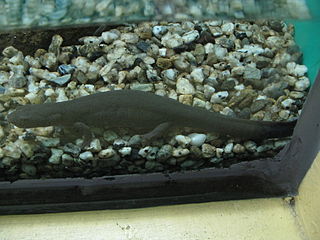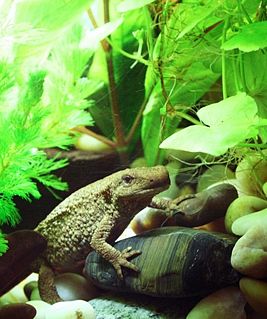
The sword-tail newt is a species of true salamander from the Ryukyu Archipelago in Japan. It has recently been placed on Japan's Red List of Threatened Amphibians. Sword-tail newts are poisonous, and may also be referred to as fire-bellied newts due to the orange coloration of their underside. They are not to be confused with the common Chinese and Japanese species. It is distinguished from these two species by their larger size, broader heads and smoother skin. Its coloration ranges from brown to black, occasionally with an orange dorsal stripe. Some individuals may have light spotting or speckling on their backs.

The Chinese fire belly newt is a small black newt, with bright-orange aposematic coloration on their ventral sides. C. orientalis is commonly seen in pet stores, where it is frequently confused with the Japanese fire belly newt due to similarities in size and coloration. C. orientalis typically exhibits smoother skin and a rounder tail than C. pyrrhogaster, and has less obvious parotoid glands.
The spotted paddle-tail newt is an amphibian native to southeastern China; it was named in 1876. A member of the family Salamandridae, it is closely related to the spotless paddle-tail newt. The spotted paddle-tail newt lives in streams and is characterized by its long, paddle-shaped tail used for propulsion.

Paramesotriton labiatus is a species of newt in the family Salamandridae. It is endemic to Guangxi, China. In literature prior to 2011, this species may have been confused with Paramesotriton chinensis, Pachytriton granulosus, or Paramesotriton ermizhaoi. This species has several vernacular names, including Unterstein's newt, spotless stout newt, spotless smooth warty newt, Zhao Ermi's smooth warty newt, and paddletail newt.

The Hong Kong warty newt or Hong Kong newt is the only species of salamander, found in Hong Kong. Once thought to be endemic to the territory, the species has also been found in the coastal parts of Guangdong Province.

Notophthalmus meridionalis, the black-spotted newt or Texas newt, is a species of aquatic newt native to northeastern Mexico and southern Texas in the United States.

Anderson's crocodile newt, Anderson's newt, Ryukyu spiny newt, or Japanese warty newt is a species of salamander in the family Salamandridae found in the Ryukyu Islands of Japan, and, at least formerly, Mount Guanyin in northern Taiwan, where it is now believed to be extinct.

Paramesotriton, also known as warty newts or Asian warty newts, is a genus of salamanders in the family Salamandridae. The genus is found in southwestern and southern China and in northern Vietnam. Most of the species are endemic to China, and the majority of them have been described recently, since 2008. The genus includes both pond and stream dwellers.

The Chinese warty newt is a species of salamander in the family Salamandridae. It is found only in China, with a range extending from Chongqing to Hunan, Anhui, Zhejiang, Fujian, Guangdong, and Guangxi Provinces in Central China. Its natural habitats are subtropical or tropical moist lowland forests, rivers, and freshwater marshes. It is threatened by habitat loss. Female Chinese warty newts reach total length of 151 mm (5.9 in), males are slightly shorter.
The Wanggao warty newt is a species of salamander in the family Salamandridae found only in northeastern Guangxi, China, in Zhongshan, Fuchuan and Gongcheng counties. Its natural habitats are subtropical or tropical moist lowland forests, subtropical or tropical seasonally wet or flooded lowland grassland, and rivers. It is threatened by habitat loss.
Paramesotriton guangxiensis, the Guangxi warty newt, is a species of salamander in the family Salamandridae. It is found only in China: it is only known from Paiyangshan, Ningming County, in Guangxi Province. Its natural habitats are subtropical or tropical moist lowland forests and rivers. It is threatened by habitat loss.
The Laos warty newt, Laotriton laoensis, is a species of salamander in the family Salamandridae. It is found only in the Saysomboun Special Zone and Phou Kout District in Xiangkhouang Province, Laos. Its natural habitats are subtropical or tropical dry shrubland and rivers. In 2014, it is classed as Endangered.

The Algerian ribbed newt is a species of salamander in the family Salamandridae found in Algeria and Tunisia. The natural habitats of this newt are rivers, intermittent rivers, swamps, cisterns, freshwater marshes, intermittent freshwater marshes, and ponds. It is threatened by habitat destruction.

The Carpathian newt, or Montandon’s newt, is a species of salamander in the family Salamandridae found in Czech Republic, Poland, Romania, Slovakia, and Ukraine.

The southern marbled newt or pygmy marbled newt is a species of salamander in the family Salamandridae. It is found in Portugal and Spain. Its natural habitats are temperate forests, Mediterranean-type shrubby vegetation, rivers, intermittent rivers, freshwater marshes, intermittent freshwater marshes, arable land, pastureland, rural gardens, water storage areas, ponds, open excavations, irrigated land, canals and ditches. It is threatened by habitat loss.

A newt is a salamander in the subfamily Pleurodelinae. The terrestrial juvenile phase is called an eft. Unlike other members of the family Salamandridae, newts are semiaquatic, alternating between aquatic and terrestrial habitats. Not all aquatic salamanders are considered newts, however. More than 100 known species of newts are found in North America, Europe, North Africa and Asia. Newts metamorphose through three distinct developmental life stages: aquatic larva, terrestrial juvenile (eft), and adult. Adult newts have lizard-like bodies and return to the water every year to breed, otherwise living in humid, cover-rich land habitats.
Paramesotriton yunwuensis is a species of salamander in the family Salamandridae. It is endemic to the Yunwu Mountains in Guangdong, southern China. Its type locality is near Nanchong village, Fuhe, Luoding City. Common name Yunwu warty newt has been coined for it.
Pachytriton inexpectatus is a species of salamander in the family Salamandridae. It is endemic to southern China and found in the Guizhou, Hunan, Guangdong, and Guangxi provinces. Its type locality is Mount Dayao of Jinxiu Yao Autonomous County, Guangxi. Prior to naming of this species in 2011, it was confused with Pachytriton labiatus. It is one of the several species that can appear in the pet trade as paddletail newt. The specific name inexpectatus is Latin meaning "unexpected" and refers to finding a species that is common in pet trade but lacked formal scientific description. Common name Yaoshan stout newt has been coined specifically for this species.












